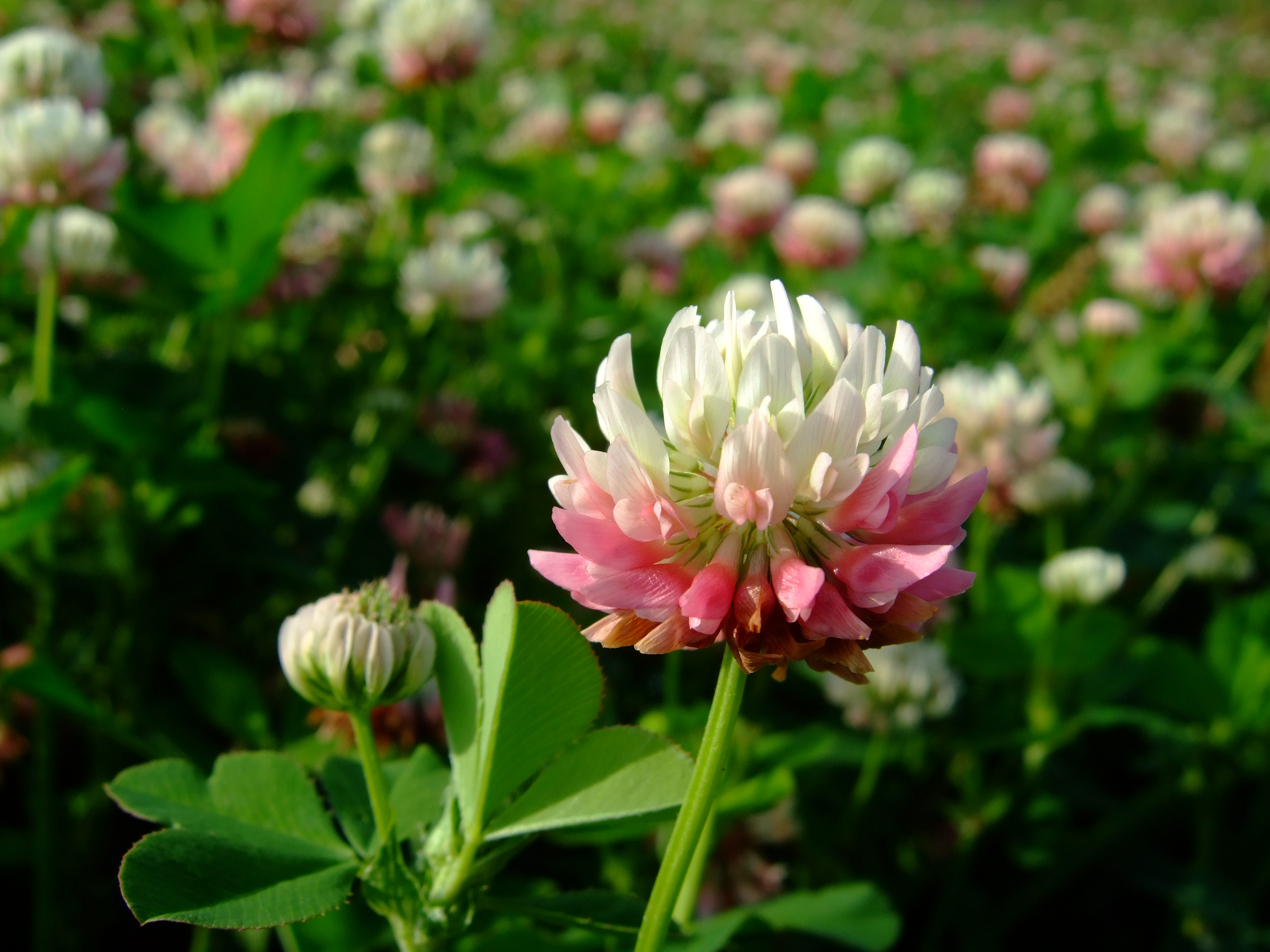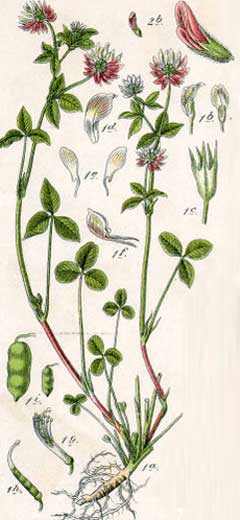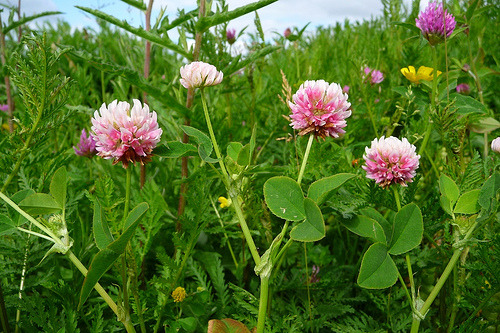Trifolium hybridum
Sweden Clover (Trifolium hybridum ) - inflorescence
The Sweden - clover ( Trifolium hybridum ), also called Bastard Clover, is a widespread flowering plant in the genus clover ( Trifolium ).
Description
Sweden Clover is a perennial, herbaceous plant that reaches the plant height 10-70 centimeters. The upright or ascending stems are bald or nearly bald and quite bare during senescence. They are highly branched, rarely almost unbranched. Often the plants are individually, sometimes in clumps together.
The change-constant and long -stalked leaves are in three parts. The 1 mm long stalked leaflets are 1-3 inches long and 1 to 1.8 inches wide. They are obovate, rarely rhombic, with a short wedge- shaped base. The leaf margins are entire or finely dentate to serrate, the apex is emarginate or vice versa heart-shaped. The petioles are long and 1 cm.
The smooth side leaves are 1 to 2.5 inches long and 5 mm wide. They are obovate to lanceolate and grow together with petioles one-third of their length. The free part is tapered and is sharply pointed or acuminate ( pfriemförmig ), he is more or less häutchenartig.
Sweden Clover flowers from May to September. The axillary spherical, capitate inflorescences reach a diameter of 1 to 2.5 centimeters and contain at least 10 (usually 30 to 50 ) Butterfly flowers. The inflorescence axes are weak and longer than the opposite leaves and increasing slightly hairy towards the head. The bracts are about one millimeter long and lanceolate. The flower stems are up to 4-5 mm long and bent back after flowering. The hermaphrodite flowers are zygomorphic and fünfzählig.
The five sepals are fused Roehrig. The cup is up to four millimeters long, he is almost bald and is completely bald during senescence. The white calyx tube is häutchenartig with five distinct and five inconspicuous ribs. The calyx teeth are unequal and one to two times longer than the calyx tube. The green- red calyx teeth lanceolate or pfriemförmig, with wide valleys between them. The Crown 0.7 to 1 centimeter high. The flowering of the white, pink or flesh-colored later petals are oblong ovate and finely denticulate in the upper half. Nine of the ten stamens are fused together. The single green, upper permanent carpel is about 2.2 mm long and contains one to twelve seeds of plants. The stylus is about 2.5 mm long.
There are two to viersamige formed, stalked, smooth legumes, which are about 7 mm long and 2 mm wide. They are elongated and protrude only slightly from the chalice. The reddish seeds are ovate with small tubercles. The seed weight corresponds to about one kilogram per 500,000 seeds.
The chromosome number is 2n = 16
Ecology
Sweden Clover is self-sterile and is pollinated primarily by honey bees. His nectar contains 43 percent sugar, each flower produced within 24 hours on average but only 0,011 milligrams of sugar.
Occurrence
The Sweden - clover has a wide distribution in Eurasia.
The Sweden - clover is native throughout Europe including the Canary Islands. The range extends to the west up to and including the whole of Portugal and in the south to 42 ° north latitude, which corresponds approximately to the height of Rome and Skopje. In the north, in Scandinavia, it extends to the latitude 60 ° N, which corresponds approximately to the height of Oslo. Some locations also lie further north. To the east, the range extends to the Caucasus and further north as far as Moscow. It is widespread throughout Germany.
There are large deposits neophyte in the United States of America. There, the Sweden - clover is on the east coast. From north to south the range extends there from New York to South Carolina. To the west it reaches to Ohio. Some locations are also found much further west.
Sweden Clover grows mainly on meadows and pastures, but also on roadsides on wasteland and riverbanks.
Varieties
In Trifolium hybridum three varieties are currently valid:
- T. h var anatolicum ( Boiss. ) Boiss. With tuft-like habit. Branches at the base. Inflorescences rather small (<2 cm diameter)
- T. h var elegans ( Savi ) Boiss. Sprossachse prostrate to ascending. Much branched. Inflorescences rather small (<2 cm diameter)
- T. hybridum var h: Stems hollow and upright. Inflorescences large ( ~ 2.5 cm diameter).
Use
Sweden Clover has importance as animal feed. He is very rich in protein and can be used as green fodder for silage as well. In Europe, higher-yielding tetraploid forms were cultured with 32 chromosomes. It can cut up to three times a year and made the first cut up to 5.6 tons per hectare and at the other sections still between 4.5 and 5.5 tons per hectare.
For humans, Sweden clover is edible. Leaves and inflorescences can be eaten raw or cooked. The dried inflorescences a tasty tea can be prepared, which should increase the flow of milk during lactation.
Swell
- Http://www.missouriplants.com/Whitealt/Trifolium_hybridum_page.html profile with detailed photos and a short description. (English )
- Description in the Western Australian flora. (English )









